#Nonlinearity
Explore tagged Tumblr posts
Text
Survey about Mystery Flesh for uni project!
Hi!! We are a team of university students in Brazil and we are studying literature and transmediatic narratives. We have chosen to produce a study about Mystery Flesh Pit National Park as an example of a transmediatic and nonlineanear story.
It uses unique methods for worldbuilding and storytelling and motivates the reader to understand the details piece-by-piece to reach the bigger picture. Despite having a loose timeline of events, it is not told chronologically and uses various formats (pictures, pamphlets, audios, etc.) to compile information.
I personally discovered Mystery Flesh Pit a couple of years ago and became obsessed with it and how it's able to mix lovecraftian horror, late capitalism and the very real, shared american experience of visiting national parks. I was very excited when I got the chance to study it for my English degree.
We have prepared a quick survey to gather data about how you, as a reader and explorer of MFPNP, experienced the story and the fandom surrounding it. If you could please spare a couple of minutes to answer our questions, it would be of great help! We will be using the data for our research, but it'll be completely anonymous.
Thank you !
#mystery flesh pit#mystery flesh pit national park#survey#literature#transmedia storytelling#nonlinearity#henry jenkins#trevor roberts
5 notes
·
View notes
Text
Aspects of the Philosophy of Complexity
The philosophy of complexity is an interdisciplinary field that explores the fundamental principles underlying complex systems and phenomena in nature, society, and technology. It seeks to understand the emergent properties, self-organization, and dynamics of complex systems, as well as their implications for philosophy, science, and society. Some key aspects of the philosophy of complexity include:
Emergence: Emergence refers to the phenomenon where complex systems exhibit properties and behaviors that cannot be understood by analyzing their individual components in isolation. Instead, these properties arise from the interactions and relationships between the components of the system. Emergent phenomena are often characterized by novel, higher-level patterns and structures that cannot be reduced to the properties of their constituent parts.
Self-Organization: Self-organization is the process through which complex systems spontaneously organize and adapt to their environment without external guidance or control. It involves the emergence of ordered structures, patterns, or behaviors from the interactions between the system's components. Self-organization is a fundamental feature of many natural systems, including biological organisms, ecosystems, and social networks.
Nonlinearity: Nonlinearity refers to the property of complex systems where the relationship between cause and effect is not proportional or predictable. Small changes in the system's initial conditions or parameters can lead to disproportionately large and unpredictable outcomes, known as nonlinear dynamics or "chaos." Nonlinear phenomena are ubiquitous in nature and can give rise to diverse patterns of behavior, such as fractals, turbulence, and phase transitions.
Networks and Interconnectedness: Complex systems often exhibit network structures, where components are interconnected through networks of relationships or interactions. Network theory explores the topology, connectivity, and dynamics of these networks, revealing important insights into the organization and functioning of complex systems across diverse domains, including social networks, neural networks, and ecological networks.
Adaptive Systems: Complex systems are often adaptive, meaning they can adjust and evolve in response to changes in their environment or internal dynamics. Adaptation involves the acquisition of new information, the modification of behaviors or structures, and the selection of advantageous traits through a process of feedback and learning. Adaptive systems are resilient and capable of self-regulation, enabling them to survive and thrive in changing conditions.
Holism and Reductionism: The philosophy of complexity challenges traditional reductionist approaches to understanding the world, which seek to explain complex phenomena by breaking them down into simpler, more manageable parts. Instead, complexity theory emphasizes the holistic and integrative nature of complex systems, emphasizing the importance of studying systems in their entirety and considering the interactions between their constituent elements.
Overall, the philosophy of complexity provides a framework for understanding the interconnectedness, diversity, and dynamism of the world around us, offering valuable insights into the nature of reality, cognition, and social organization.
#philosophy#epistemology#knowledge#learning#chatgpt#education#metaphysics#Emergence#Self-organization#Nonlinearity#Networks#Adaptive systems#Holism#Reductionism#Complex systems#Philosophy of science#Systems theory
2 notes
·
View notes
Text
'STOP THE ROT' UK, CANADA, INTERNATIONAL FREE RESOURCES 2018-2024 #GovernmentMisMANagementTraditions #EndPatriarchy #NonLinearity #InYourOwnWay #Landback #SelfDetermination #WeAreNature #NatureIsUs #EndFossilFuelColonialism #Equity #ClimateJustice
#GovernmentMisMANagementTraditions#EndPatriarchy#NonLinearity#InYourOwnWay#Landback#SelfDetermination#WeAreNature#NatureIsUs#EndFossilFuelColonialism#Equity#ClimateJustice
0 notes
Text
The World Is Still Being Made: Living the Sacred Surprise | ChatGPT4o
[Download Full Document (PDF)] This document, titled “The World Is Still Being Made,” is a spiritual guidebook that invites readers on a transformative journey through themes of mystery, creation, and personal evolution. It emphasizes the importance of embracing uncertainty and the sacredness of the ongoing process of becoming. Overview of the Journey The book is structured into four main parts:…
#Animism#Bayo Akomolafe#Ceremony#ChatGPT#Coherence#Embodied Spirituality#Initiation#inner work#Integral Healing#Kintsugi#Living Cosmology#Morphic Resonance#Mystery#Mythic Rhythm#Mythopoetic Descent#Nonlinearity#Participatory Creation#Pilgrimage#Process Philosophy#Regenerative Presence#Return#Sacred Practice#sacred time#Sacred Wild#Somatic Prayer#Soul Ecology#Spiral#Threshold#Trauma and Healing#Unknowing
0 notes
Text
Harnessing the Chaos: Transforming Uncertainty into Innovation.
Sanjay Kumar Mohindroo Sanjay Kumar Mohindroo. skm.stayingalive.in How Chaos Theory Ignites Breakthroughs in Business, Technology, and Life Discover how chaos theory transforms uncertainty into opportunity with the butterfly effect, fractals, and innovative leadership in business and life. Embracing the Unpredictable Discover the transformative role of chaos theory in redefining our approach…
#Adaptive Policies#Agile Systems#Attractors#Bifurcation#Business Innovation#Butterfly Effect#Chaos Theory#Deterministic Chaos#digital transformation#Edge Of Chaos#Emergence#Feedback Loops#Fractals#Leadership#Lyapunov Exponents#News#Nonlinearity#Phase Space#Risk Management#Sanjay Kumar Mohindroo#Self-Similarity
1 note
·
View note
Text

#ds9#kira nerys#i just realized that i never posted this here lol#anyway! i love playing with the symbolism of nonlinear time and grief/trauma#you can only exist in one present moment but you will still always be bound to your own bloody history#kinda thing#i love kira a lot tbh#my stuff
1K notes
·
View notes
Text

close again and closer still
#my art#jujutsu kaisen#jjk#yuji itadori#megumi fushiguro#itafushi#fanart#jjk fanart#jujutsu kaisen fanart#yuuji#megumi#as promised ! a break from the angst pls accept my humble apology fr any and all emotional damage#coping is nonlinear and today i cope with itfs making out#fr some reason these took a lot longer than they should have tho????#i think its just tht kissing poses take so much effort 2 get to look natural cries#it takes so much out of me every time sighs i gave up fully rendering th top one bc i just want 2 b done#happy w them tho !#god i have . such a weakness fr megu grabbing @ yuuji's hood i blame that one scene#hands in clothes hands in hair hands on neck i CRY#fushiguro touch starved megumi is Eating in this household today
2K notes
·
View notes
Text
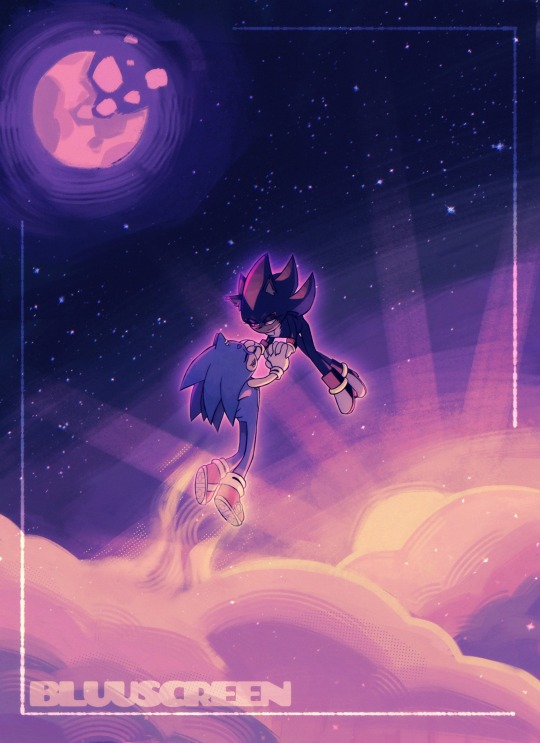
god of the wind / god of the stars
#sth#sth fanart#sonic the hedgehog#shadow the hedgehog#sonadow#shadonic#fanart#this is technically part of an au i’ve been rotating in my head#their *full* titles are god of the wind + freedom + the bright side of the moon#and god of the sun + stars + the darkness in between them#yk how a lot of greco-roman gods are known for like one or two things but they actually have a bunch#of random domains#like how apollo is the sun and music and prophesy etc.#this is kinda like that#their shoes are different because i was gonna give them little outfits but decided not to#and just left the shoes#anyways most of the main cast gets to be gods eventually#its a whole nonlinear reincarnation thing i’ll explain it whenever i can rlly nail it down#for now just look at the pretty purple oooo aaaa
796 notes
·
View notes
Text
A Belousov–Zhabotinsky reaction, or BZ reaction, is one of a class of reactions that serve as a classical example of non-equilibrium thermodynamics, resulting in the establishment of a nonlinear chemical oscillator.
1K notes
·
View notes
Text

and if you don't dance you will be still
and if you're still you will never move again
study of this piece by megumi sugizaki !! apologies that i can't find it in any higher resolution

#while this is a study i got overly analytical abt milla over it. of her pushing herself to remain true to the persona she's built#even when shes so very tired. she has to keep moving. i think she struggles reckoning with the nonlinearity of recovery#i will expand on this more one day but .yeag. this was really fun thankyou pinterest algorithm :]#maple doodles#psychonauts#psychonauts fanart#milla vodello
275 notes
·
View notes
Text

#columbo#season 7#how to dial a murder#jokes on you lieutenant that dog teaches nonlinear optics at caltech and you'll never know
989 notes
·
View notes
Note
Hello!! I hope you're having a good day ^^ I came across your post about writing non-linearly on Notion and I'm excited to try it out because the advice resonated with me! Though, I'm really new to using the app and, if possible, need help with how to do this part: 'where every scene is a separate table entry and the scene is written in the page inside that entry.' ;v;
Hello! Thank you so much for messaging!!! Since that post about writing non-linearly (linked for context) blew up roughly ten thousand times as much as anything I've ever posted, I've been kind of meaning to make a followup post explaining more about how I use Notion for writing non-linearly, but, you know, ADHD, so I haven't done it yet. XD In the meantime, I'll post a couple screenshots of my current long fic with some explanations! I'd make this post shorter, but I'm unable to not be Chatty. XD (just ask my poor readers how long my author notes are...) (There is a phone app as well which syncs with the desktop/browser versions, but I work predominantly in the desktop app so that's what I'm gonna be showing)
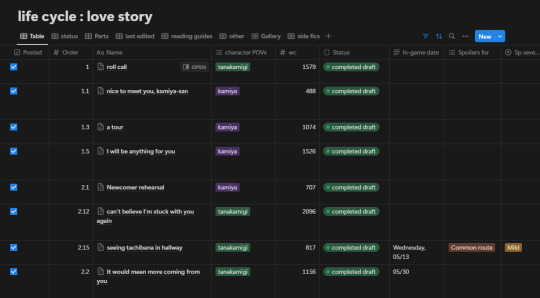
(the table keeps going off the right side of the image but it's a bunch of unimportant stuff tbh) So this is more complicated than what you'll probably start with because I'm Normal and add a bunch of details that you might not need depending on what you're doing. For example, my fic switches POVs so I have a column for tracking that, and my fic follows a canon timeline so I have a column for dates so I can keep track of them, and I also made columns for things like if a scene had spoilers or certain content readers may want to avoid, which they can access in my spoiler and content guide for the fic. (As I said, I'm Normal.) I also do some complicated stuff using Status and estimated wordcount stuff to get an idea of how long I predict the content to be, but again, not necessary. Anyway, you don't need any of that. For the purposes of this explanation, we're just gonna look at the columns I have called Name, Order, and Status. (And one called Part, but we'll get into that later) Columns in Notion have different types, such as Text, Numbers, Select, Date, etc, so make sure to use the type that works best for the purpose of each column! For example, here I'm using Select for Character POVs, Number for Order and WC (wordcount), and Text for the In-Game Date. Okay let's get into it! Name is a column that comes in a Notion table by default, and you can't get rid of it (which drives me up the wall for some purposes but works totally fine for what we're doing here). As you can see on the scene I've labeled 'roll call', if you hover over a Name entry, a little button called 'Open' appears, which you click on to open the document that's inside the table. That's all default, you don't have to set anything up for it. Here's a screenshot of what it looks like when I click the one titled 'I will be anything for you' (I've scrolled down in the screenshot so you can see the text, but all the data fields also appear at the top of the page)
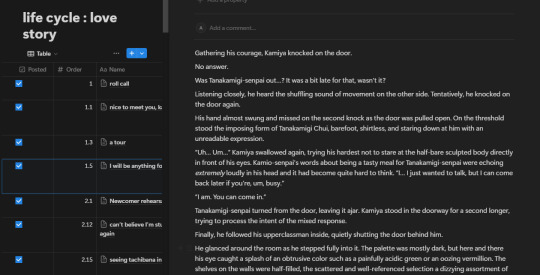
(This view is called 'side peek' meaning the document opens on one side and you can still see the table under it on the left, which is what mine defaults to. But you can set it to 'center peek' or 'full page' as well.) All my scenes have their own entry like this! Note that I've said scenes, not chapters. I decide the chapters later by combining the scenes in whatever combination feels right, which means I can often decide in advance where my chapter endings will be. This helps me consciously give most of my endings more impact than I was usually able to do when I tried to write linearly. So hopefully that gives you an idea of what I mean by writing inside the table and treating the table as a living outline. The 'Status' column is also pretty straightforward, and might require a little setup for whatever your needs are. This is another default column type Notion has which is similar to a Select but has a few more specialized features. This is how mine is set up:
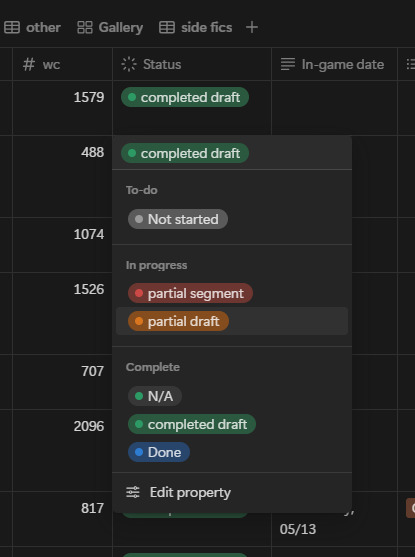
(I don't actually use 'Done', idk why I left it there. Probably I should replace it with 'Posted' and use that instead of the checkmark on the far left? whatever, don't let anyone tell you I'm organized. XDD)
Pretty straightforward, it just lets me see easily what's complete and what still needs work. (You'll notice there's no status for editing, because like I mentioned in my other post, I don't ever sit down to consciously edit, I just let it happen as I reread) Obviously tailor this to your own needs! The Order column is sneakily important, because this is what makes it easy for me to keep the scenes organized. I set the Sort on the table to use the Order to keep the scene ordered chronologically. When I make the initial list of scenes I know the fic will have, I give all of them a whole number to put them in order of events. Then as I write and come up with new scene ideas, the new scenes get a number with a decimal point to put them in the spot they fit in the timeline. (you can't see it here, but some of them have a decimal three or four digits deep, lol). Technically you can drag them to the correct spot manually, but if you ever create another View in your table (you can see I have eight Views in this one, they're right under the title) it won't keep your sorting in the new View and you'll hate yourself when it jumbles all your scenes. XD (And if you get more comfortable with Notion, you probably will at some point desire to make more Views) The Part column isn't necessary, but I found that as the fic grew longer, I was naturally separating the scenes into different points along the timeline by changes in status quo, etc. (ex. "this is before they go overseas" "this is after they speak for the first time", stuff like that) in my mind. To make it easier to decide where to place new scenes in the timeline, I formalized this into Parts, which initially I named with short summaries of the current status quo, and later changed to actual titles because I decided it would be cool to actually use them in the fic itself. Since it's not in the screenshots above, here's what the dropdown for it looks like:
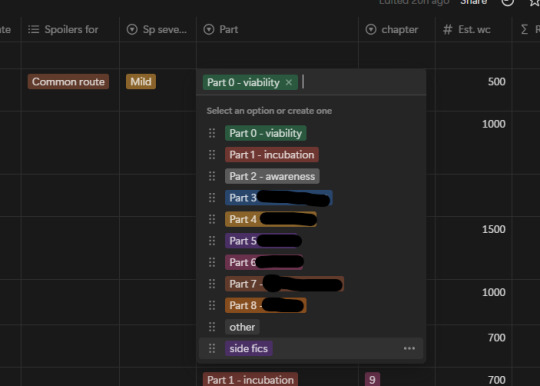
(I've blocked some of the titles out for spoiler reasons)
Basically I only mention the Parts thing because I found it was a useful organizational tool for me and I was naturally doing it in my head anyway. Anyway, I could keep talking about this for a really long time because I love Notion (don't get me started on how I use toggle blocks for hiding content I've edited out without deleting it) but that should be enough to get started and I should really, you know, not make this another insanely long post. XDD And if anybody is curious about how the final results look, the fic can be found here.
#notion#writing resources#writing advice#writing#writers block#writers on tumblr#writeblr#nonlinear#fanfic#fanfiction
583 notes
·
View notes
Text
introducing bing and also larry. wahoo
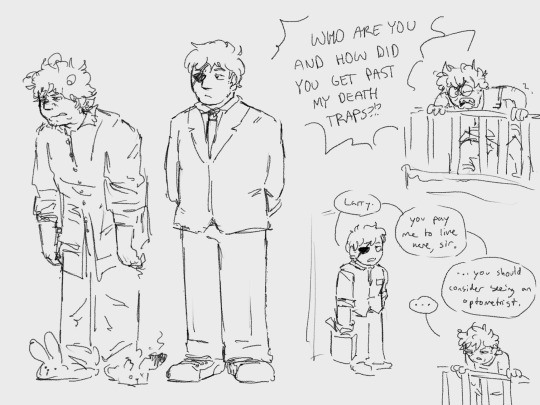
in my version larry is bings nephew. bings (significantly older) sister heard hes a scientist now and was like "oh my darling larry you should go ask your uncle for an internship!!"




#larry still has both eyes bing just want him to have the eyepatch to play the part of 'evil henchman' better#my art#eddsworld#sketch#ew bing#ew larry#theyre like 29 and 21 in the comic. which is like a decade before the events of spares#we do NOT ship binglarry here. they are related and also bing is aroace#hes too busy planning to take over the world#time: nonlinear
174 notes
·
View notes
Text
when i was around 9 my family cat died and i was understandably upset about it. so a few days later in my elementary catholic class (italian thing. ask mussolini about it and then hang him again) i drew a picture of "what i thought heaven looked like". and what heaven looked like to me was god standing around with an arm around jesus' shoulders being like "and THEN my wonderful son did this..." with jesus looking visibly embarrassed, because that's how a good dad is supposed to act, while all the angels and souls of the departed sat at their feet looking impressed in their wings and haloes. various pets being among them, such as my cat, my grandpa's old dog etc, also behaloed and winged. except when i went to show my drawing to the teacher explaining my artistic thought process, she looked at it and went "nice. but animals don't go to heaven because they don't have souls like us."
i wish. oh how i wish every day of my life that i'd been the hypersensitive, quick-to-tears kid that would've undoubtedly triggered a whole class religious schism when my classmates found out why i was screaming and sobbing my eyes out. but alas, i just discarded her theological theory altogether. what a silly woman she was. she must've never had pets, otherwise she'd clearly know they DO have a soul. boy, was she gonna get a surprise when she got to heaven.
now that i think back on it, you have to laugh at the heartless, eye-opening cruelty of looking a grieving child in the eye and saying "sorry kid, little mina's not getting into heaven." what a succinct summary of catholicism. anyway, I'm not christian anymore.
#giving the church its due. my stance on animal souls was rather nonlinear#for example: cats/dogs had souls but cows didn't. that is because i never saw the body of my dead cats until i had to put one down at age 1#(17 being my age. the cat was probably in her 20s)#while i used to sneak out to watch the vet autopsy the stillbirth calves at my grandpa's neighbors' farm#there was no soul in there. i specifically looked out for it#anyway. that's the biscia tmi of the day
1K notes
·
View notes
Text
Writing Notes: Non-Linear Storytelling

Non-linear Narrative - a narrative technique in which the storyline is told out of chronological order.
That can take many forms by using:
flashforwards
flashbacks
dream sequences
foreshadowing
Non-linear plotlines can mimic the recall of human memory, or weave in fantastical elements like time travel or clairvoyance.
Advantages of Using a Non-Linear Narrative
Non-linearity as a narrative structure might be a challenge to pull off—the order in which everything is presented must still be logical, if not chronological—but when done well, it allows a more nuanced, masterful story to emerge.
Intrigue. By disorienting the reader, a nonlinear structure creates a puzzle that requires more engagement with the individual pieces of the story. Cause and effect cease to be predictable or immediately visible, allowing the reader to curate their own logic. When a novel opens with a murder, the series of events that follow carry greater weight and add to the anticipation of the final (known) outcome. When the reader knows more about a character’s fate than they do, opportunities also arise for moments of irony, be they tragic or comic.
Worldbuilding. Not only can you use a non-linear structure to incorporate different time periods into your story, taking a momentarily different point of view can give the reader more insight into other aspects of the setting—think subplots unfolding on the other side of the world that will eventually become meaningful, or perhaps historical events that come to bear on the lives of your characters.
Depth of character. The more the reader learns of your main character’s backstory, the better they understand the choices they make throughout the narrative. Instead of simply telling the reader your character is an orphan, send them back to the moment they became one. Those experiences stay with the reader as they continue through the story.
Flow. Nonlinear storytelling moves your narrative form into something closer to art. While humans might be instinctually drawn to the neatness of chronological order, they are enchanted by the complex. Interchanging the main plot with a non-linear plot allows you to capture more of what it means to be human, and then some: giving shape to all the connections that bind a group a people together, though they themselves remain blind to it.
Examples of Non-Linear Narrative
Non-linear storytelling goes as far back as the 5th century, with flashbacks peppering the timeline of the Indian epic, the Mahabharata, which tells of two clashing groups of cousins. Homer’s Iliad used a technique called in medias res, where the story starts at its mid-point.
The non-linear is still going strong in the 21st century: here are a few new and noteworthy examples.
Virginia Woolf’s To The Lighthouse follows a family’s visit to the Isle of Skye over a ten-year period. Featuring no dialogue and almost no action, the novel unfolds in thoughts, observations, and childhood memories reflected against the present moment.
In William Faulkner’s The Sound and The Fury, the narrative is pieced together by separate members of a fractured aristocratic family. Each section jumps forward and back in time, covering the events whose ripples have led to the present fate of the family.
Kurt Vonnegut, whose book Slaughterhouse-Five utilizes flashback and time travel to illustrate the life of American soldier Billy Pilgrim.
Science-fiction writer Ted Chiang’s first-person short story, Story of Your Life (which was later made into the film Arrival) examines the existence of free will in the face of the inevitable. Told from the point of view of a Louise, a linguist who learns an alien language that allows her to view her future and comprehend time in a nonlinear way, the story opens with the birth of her daughter; the reader only learns later that she knew the child would die young and still chose to fulfill that destiny.
In Audrey Niffenegger’s The Time Traveler's Wife, protagonist Henry De Tamble lives with a genetic disorder that forces him to sporadically travel through time with no warning. He falls in love with an artist (who lives an ordinary life on a standard linear timeline) and continues to jump in and out of moments in his own life, sometimes with dangerous consequences.
Source ⚜ More: Notes & References ⚜ Writing Resources PDFs
#nonlinear#writing notes#writeblr#literature#writers on tumblr#dark academia#writing reference#spilled ink#writing prompt#creative writing#writing tips#writing advice#on writing#writing inspiration#writing ideas#writing resources
91 notes
·
View notes
Text
to the anon that sent me an ask a couple of hours ago about mumbo: what a wonderful question ily. taps my forehead and points at you. very cool. very good Eye
#LIKE. there's a LOT that the timeline is missing--don't worry I have a version of these timelines with everything currently planned on them#but you are seeing the pieces that don't add up and I have to be like. oh shoot yeah that DOESN'T make sense does it (on purpose)#i appreciate that some of y'all really poke thru things and squint ur eyes at things >w<#I DONT EXPECT EVERYONE TO THO YKNOW LIKE I'M NEVER DISAPPOINTED WHEN RLY SUBTLE THINGS DON'T GET PICKED UP DW#BUT! theres so many smart ppl who put things in my inbox and im like YOU DID IT YOU FOUND THE SUSPICIOUS PIECES i can't answer this yet tho#because i dont want it to be THAT obvious that something is weird. yknow. yknow. do u understand me#anyway it's legit not that deep /srs but#its so fun to realize ive accidentally put things on there that are like. ah well. that's not really explainable right now... uhhhhh#until I'm able to draw a comic for it#BUT YEA#skips and jumps around#nonlinear storytelling i love you#dbhc#dbhc ask#ask#anon
132 notes
·
View notes